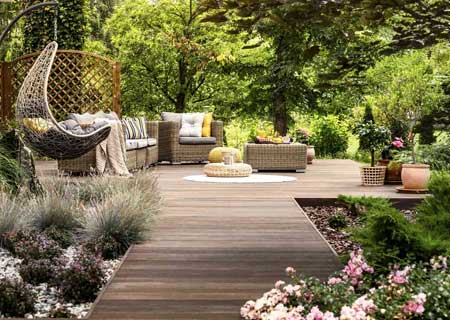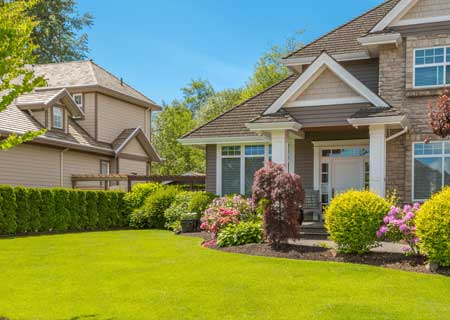Creating a well-designed outdoor space requires a balance between structure and natural elements. This balance is achieved through hardscaping and softscaping, two essential components of landscape design. Understanding their differences is key to creating functional and visually appealing outdoor spaces.
Outdoor spaces are more than just extensions of your property; they are places for relaxation, recreation, and connection with nature.
- Hardscaping refers to the structural elements of your landscape, such as patios and pathways.
- Softscaping encompasses the living elements, like plants and trees.
Understanding the distinction between these two components helps homeowners create landscapes that are both functional and aesthetically pleasing. This blog explores the concepts of hardscaping and softscaping, their benefits, and why integrating both is the ideal approach for designing your dream landscape.
What is Hardscaping?

Definition and Components
Hardscaping refers to the non-living, structural features in your outdoor space. Common hardscaping components include:
- Patios and decks
- Walkways and driveways
- Retaining walls
- Pergolas and gazebos
- Outdoor kitchens and fire pits
Materials Used in Hardscaping
Hardscaping elements are constructed using durable materials such as:
- Concrete and pavers
- Natural stone and brick
- Gravel and wood
Benefits of Hardscaping
- Durability and Low Maintenance: Hardscaping elements are designed to withstand weather conditions and require minimal upkeep.
- Versatility in Design: Structural elements can be customized to fit various styles, from modern to rustic.
- Increased Property Value: High-quality hardscaping enhances curb appeal and boosts resale value.
What is Softscaping?

Definition and Components
Softscaping involves the living elements of your outdoor space, such as:
- Trees and shrubs
- Flowers and ornamental plants
- Grass and ground covers
Importance in Outdoor Space Design
Softscaping contributes significantly to the visual and functional appeal of a landscape. Its living elements bring vibrancy and natural beauty, providing seasonal interest and ecological benefits.
Benefits of Softscaping
- Enhanced Visual Appeal: Lush greenery and colorful blooms create a welcoming ambiance.
- Environmental Benefits: Plants improve air quality, reduce noise pollution, and support local wildlife.
- Increased Biodiversity: Softscaping fosters ecosystems by attracting birds, bees, and other beneficial species.
Key Differences Between Hardscaping and Softscaping
Materials and Construction
- Hardscaping: Uses solid materials like stone, brick, and concrete to create permanent structures.
- Softscaping: Involves living, organic materials that require planting and nurturing.
Maintenance and Upkeep
- Hardscaping: Low-maintenance, with occasional cleaning or sealing.
- Softscaping: Requires regular care, including watering, pruning, and fertilizing.
Functionality and Purpose
- Hardscaping: Provides functionality, such as seating areas, pathways, and retaining walls.
- Softscaping: Adds aesthetic and environmental value through greenery and natural textures.
Aesthetic Appeal and Design Flexibility
- Hardscaping: Creates structure and defines space.
- Softscaping: Adds warmth, color, and seasonal variation.
Benefits of Combining Hardscaping and Softscaping
The most impactful landscapes integrate both hardscaping and softscaping to achieve balance and harmony.
Advantages of Integration:
- Balanced Design: Hardscaping provides structure, while softscaping softens the space with natural elements.
- Enhanced Functionality: Combining paths, patios, and plants creates outdoor spaces that are both usable and beautiful.
- Increased Property Value: A thoughtfully designed landscape that blends structural and natural elements significantly boosts curb appeal.
For example, a stone patio surrounded by lush flower beds or a walkway lined with trees creates an inviting and practical outdoor space.
Conclusion
Both hardscaping and softscaping are essential components of any well-designed outdoor space. Hardscaping adds structure, durability, and functionality, while softscaping enhances aesthetic appeal and supports the environment. Combining the two creates a harmonious and versatile landscape that reflects your style and meets your needs.
To bring your vision to life, trust Desert Rose Landscaping LLC – the best landscaping company in Muscat. With expertise in hardscaping and softscaping, Desert Rose ensures your outdoor space is both stunning and functional. Contact us today to start your landscaping journey!

